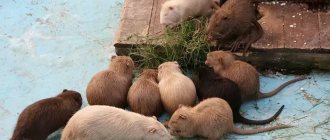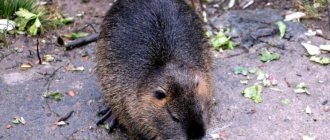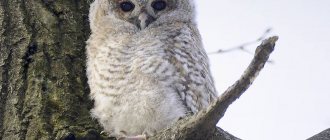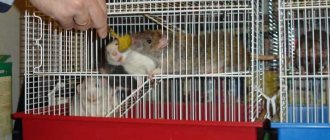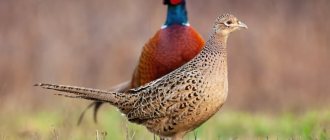Creating a family and raising chicks
As we already said in a previous publication, magpies are paired birds that create a family and care for their chicks together. A successful couple lasts a lifetime.
Birds unite in flocks and move in groups of five to seven pairs. They lead a sedentary lifestyle and winter in their homeland. Only those who live in Scandinavia make flights to warmer climes.
Magpies build intricate nests that are not so easy for predators to penetrate. They are spherical in shape and built from branches.
The bird lays its eggs in mid-spring. One clutch includes up to 8 small eggs, white with brown spots. 18 days after incubation, offspring appear. The magpie is born blind, completely naked and requires special care from its parents. The chicks are very voracious; they need to be nursed and fattened for 25 days.
Magpies have a lot of enemies. Among them are such predators as eagles, falcons, hawks, owls, eagles, and eagle owls. Animals include snakes, martens and wild cats. Their main prey is helpless chicks.
Allowed foods for tits
The most popular food for tits is seeds. But what else can you feed besides them? Simple solution: buy . The bird will be very happy with the treat.
If you don’t know which cereal to choose, pay attention to the following types:
- millet;
- oats;
- millet;
- wheat;
You can feed tits in the city from animal products:
- eggs;
- grain cottage cheese;
- unsalted lard;
- sausage.
Among the vitamin-rich foods, you can offer them dried fruits and berries.
What the owner needs to know about a magpie
What is the first thing that comes to your mind when you hear the word “magpie”? These are white sides, and the highest degree of curiosity. And, this is all true.
What does a magpie look like?
This is what a magpie looks like
The appearance of the bird is really bright, although it is based on contrasting black and white colors. The magpie's neck, head, upper chest, rump, back, tail and wings are black. Flight and tail feathers with a metallic greenish or purple sheen are difficult to describe. But the area of the chest, abdomen, and wide stripes on the wings and shoulders of the bird are white. So, you can be sure that the white-sided magpie is truly a bright bird and in its beauty it is ready to give odds to many exotic and paradise birds. The main thing is to see all this in her. However, if you are going to live with this bird in the same house, and with proper care it can live a long and happy life, which will be measured in several dozen years (there is evidence that magpies in captivity live up to 30-40 years), then you will still have time to admire her.
However, if you rely only on the appearance of the bird to determine its gender, then some difficulties await you here. Only an experienced ornithologist who is well versed in the smallest sexual characteristics of birds can accurately determine the sex of a bird (such characteristics include the different shape of the pelvis of the female and male), unless you are one, and you do not want to conduct a special examination in a veterinary clinic (it’s worth a lot of money), then you will have to rely on intuition to determine the sex of your magpie. Of course, this will significantly complicate the breeding of birds (if you suddenly decide to breed magpies at home, it will be very difficult to choose a female or male), but white-sided magpies are not intended for ornamental breeding, therefore, it is better for you to abandon your idea.
Where do magpies live in Nature?
The distribution range of this bird is very wide, from the temperate zone of Europe all the way to the east of Kamchatka; this bird was also found in northwest Africa and was even seen in the northern part of America. It is quite obvious that African magpies differ from American or ours in their appearance and body size, but the general features of their appearance will remain. Magpies prefer to settle in trees and shrubs, regardless of natural areas. But they avoid deep forests, although they can be found in forest belts, where they can live in colonies. Although, for ordinary nomadic or sedentary birds, a solitary lifestyle is preferable, but if this is necessary for survival, then magpies gather in flocks, in pairs and even in colonies.
Magpies fly heavily, often flapping their short wings, but on the ground they are ready to give a head start to any runner, since thanks to their long legs they move quickly. By the way, an interesting feature,
When walking or running on the ground, magpies always keep their tail raised high, which gives them a somewhat cocky appearance.
Birds prefer to nest in the thick of bushes or in a thicket of thorny plants, placing their nest in the shape of a ball or ellipse at a low altitude. In appearance, the bird's nest looks rather sloppy and untidy, but inside it is lined with wool, feathers and small branches, and the entrance to the nest is located on the side. An interesting fact, but magpies are born builders, so they can build several nests in a season, but they choose only one for themselves. Owls, owls and even small animals happily settle in their old nests...
What do magpies eat in Nature?
Almost everything that surrounds these birds serves as food for insects. Insects, centipedes, mollusks, worms and spiders, small birds, eggs and chicks of other species, plant foods, small fruits, seeds and even carrion - all this can be found in the diet of a wild magpie.
Distribution, habitats
Where does the magpie live in its natural habitat? The distribution area of this bird is concentrated in the Northern Hemisphere, where it is found on all its continents - Africa, Eurasia and North America. The distribution areas of the common magpie are especially extensive, covering the entire temperate climate zone of Eurasia (with the exception of the Far East).
Other species have narrower ranges. For example, the California magpie is found only on the California Peninsula, and only the thick-billed azure magpie lives in Taiwan. The habitat of the blue magpie is a real mystery. They cover two areas: one - the Far East (China, Korea, Japan, northern Mongolia, Primorye), the second - the extreme west of Europe (Portugal and Spain). To date, science has not provided any explanation for how birds of the same species became so isolated from each other.
All species have similar habitats, as well as what magpies eat. They prefer to settle in forests of various types - broad-leaved, coniferous and tropical jungles. They live in city parks, in dense thickets, and in open forests, and in forest plantations. While searching for food, they visit fairly open spaces: clearings, wastelands, shores of lakes and rivers, meadows and fields.
There are species that stay alone most of the year and form married couples and groups only after hatching eggs. There are also those that live in small flocks, and during the nesting period they break up into separate pairs.
So, what should a magpie have in its diet?
The magpie's diet must include insects.
Mealworm, zoophobas, crickets, grasshoppers, mole crickets, etc.
Forage insects must be bred on a variety of nutritious diets in order for their nutritional value to be high. Zophobass and mealworms grown on poor diets are rich in fats and poor in mineral composition and vitamins. Feeding magpies only such “fatty” foods will lead to the development of pathologies in the bird’s liver and kidneys.
During the period of mass emergence of the May beetle (Melolontha melolontha), it should be given to magpies without restrictions. At this time, it can be stored by freezing. Although, often, birds quickly become full of cockchafers, especially defrosted ones, and refuse to eat them - in this case, you need to take breaks from feeding them.
Magpie eats "ant eggs" - ant pupae. An ant egg is very rich in nutrients, but I would not recommend introducing it into the diet of magpies on an ongoing basis - since collecting ant eggs causes enormous harm to anthills and, accordingly, the forest ecosystem.
In this video, a magpie eats a blackbird. Perhaps this magpie discovered an already crashed blackbird, perhaps it caught it itself. Magpies are capable of catching both adult birds and fledglings of sparrows, tits, and pigeons.
Parrots
There are relatively fewer problems with the question of what to feed a parrot chick. To do this, use baby food without milk (for example, porridge). The mixture is diluted to a liquid state at a temperature of 37 degrees. The chick is fed every two hours, lying on its back, and introducing food from the side of the beak using a brush or an insulin syringe.
Well, have you decided to take care of the winged baby? Then good luck to you!
Very often, children bring chicks from the street that supposedly fell out of the nest, and begin to take care of them with tears. They make a nest in a box, lay it on cotton wool or rags and ask adults what to feed the chicks that have fallen out of the nest?
Not every parent is able to force the baby to take the chick back to where he brought it from, although he understands that he will have to care for the foundling.
Chick mode
Chicks need food often, once every 15-20 minutes. It will be possible to interrupt only for a night's sleep and feeding should be resumed no later than the sun rises.
What to feed the chicks depends on the type of bird they belong to. It is possible to feed a songbird, sparrow, swift, crow or pigeon at home. Almost all chicks can be returned to where they were found and will likely be cared for by their parents.
They don’t return the little ones to their place, but they can’t help the chick that has fallen out of the nest; they don’t know how to take off from the ground. You can distinguish a swift from a swallow by their paws - all the toes of swifts point forward.
Menu for chicks
Despite the fact that adult birds peck grains with pleasure, the chicks are fed protein foods. Live bloodworms, which can be purchased at pet stores, are also suitable for food, earthworms - you can dig them up yourself, flies - also caught with your own hands.
Ideally, feeding is carried out once every 20 minutes - if this does not work, at least once an hour. A piece of food must be pushed into the chick's beak, opening it by force. If you can’t get live food, then you need to mix pieces of egg yolk, cottage cheese and minced meat and make tiny balls. The chick itself does not know how to peck, but by the 3-4th feeding it understands that it needs to open its “mouth”.
What to feed His diet is no different from the diet of a sparrow. The only thing is that the tit chick may require mineral supplements and vitamins, which will have to be administered along with the food. Tit chicks are found less frequently; these birds hide their nests from people. It often happens that parents, frightened by people, lose their chick, and when the children find it, it is quite weakened.
Swallows are not being returned to the wild
Children often bring home little swallows. These birds make nests on the top floors of human homes and under balconies. What to feed the chicks of these birds? Swallows always feed on protein foods, and therefore feeding swallows is no different from nursing them. But you need to remember: if birds of other species, while growing up, are gradually transferred to grain feed and can leave their hospitable owners, a swallow raised in captivity does not return to freedom. True, live food can be replaced with a surrogate as the bird grows older - it can be switched to minced meat. It is enough to feed the swallow chick once an hour.
When it is clear what to feed the chicks, you need to clarify what to feed them and how? And most importantly - is it necessary? You can drip a couple of drops of water, introducing it further into the beak, from a pipette, but birds in the wild do not water their chicks - they get enough moisture from living food.
In order to prevent children from bringing home small birds, parents must explain to the child that the fledgling - most often children bring chicks that themselves flew out of the nest, not yet fully fledged - flew out of the nest itself and was waiting for its mother, who would feed and take care of it. And there is no need to bring such chicks home; it is better to return them to the same place so that the parents can find them. It is quite difficult to feed a chick at home.
Bird repellers
In stores you can purchase special installations that have a deterrent effect on both birds and small animals. For example, you can install ultrasonic technology that has a special effect on the brain of birds, and they try to avoid those places. But such installations cannot be used for a long time, since they also affect people.
There are special repellers that react to movement: the sensor is triggered, and a powerful stream of water bursts out towards the moving object!
There are also scented repellents that cause an unpleasant sensation in birds, and they do not go anywhere near the epicenter of the smell. All you need is to treat any porous material with repellent and install it in several places on the site.
Prohibited foods for tits
You cannot feed tits in a feeder:
- Roasted sunflower seeds
. Causes liver problems in birds. - Salty food
. Causes indigestion and stomach problems. - Spoiled products
. Causes indigestion. - Bread
. It swells in the crop and begins to ferment, causing the death of the bird.
Controversial questions often arise about whether it is possible to feed tits with millet, because toxic substances accumulate on the grain shell. In modern conditions, this is rare, but if you are still afraid for the life of the bird, pour boiled water over the millet to wash out the toxins.
You can't feed blue citrus and exotic fruits yet. The birds have not consumed them before and therefore may die due to an allergic reaction.
To watch online, click on the video ⤵
DO NOT HAVE CORAVE BIRDS!!! Don't have any corvids! More details
How to raise a magpie Pick up chicks – How to raise a magpie Pick up chicks Read more
Domestic Magpie Pigi. Curious Assistant Read more
WE SAVE the Magpie chick!!! video with animals Read more
How to tame a magpie - BATHING with coffee Read more
The house magpie is an excellent companion or “thief” with a character Read more
House Magpie VINCH. Pros (+++) and cons (- – -) Read more
Accidental find. A real treasure from the nest of a comrade's magpie. More details
The smartest bird after the crow is the magpie. Interesting facts – Birds of Russia – Film 13 Read more
Magpie thief! I checked the nest, and there... Read more
Literature
- J. C. Alonso, R. Neves, R. Rufino: Cyanopica cyana
in W. J. M. Hagemeijer, M. J. Blair:
The EBCC Atlas of European Breeding Birds – their distribution and abundance
, T & AD Poyser, London 1997, p. 674, ISBN 0-85661-091-7 - Zhang R., Song G., Qu Y., Alström P., Ramos R., Xing X., Ericson PGP, Fjeldså J., Wang H., Yang X., Kristin A., Shestopalov AM, Choe JC, Lei F.
Comparative phylogeography of two widespread magpies: Importance of habitat preference and breeding behavior on genetic structure in China (English) // Molecular Phylogenetics and Evolution: journal. - 2012. - Vol. 65. - P. 562-572. — DOI:10.1016/j.ympev.2012.07.011.
General information
They say about the magpie that it is very smart, agile, cunning and dexterous. It is believed that these birds even have a special language, thanks to which they are able to communicate important information about danger to each other.
Magpies belong to the group of birds of the corvid family. It includes representatives of 9 genera. All species of magpies are similar in appearance, despite the fact that their genera are not always closely related to each other. Due to their external similarity, they are united under one common name.
There are a total of approximately 30 species of these birds. The closest corvids to magpies are crows and jays.
Special sounds made by birds, based on which you can judge the mood of the black and white beauty
Decorating walls in the house: a review of the best materials and technologies. 90 photos of wall design options in a private house
Males are larger representatives of the species in comparison with females. This phenomenon often occurs in nature in birds, although in mammals, on the contrary, females may be larger. As for coloring, there is no difference by gender. Everyone has the same color. The tails look long and stepped in comparison with the body. The voice of these birds also deserves special attention, which, along with colors and other distinctive features, is a kind of calling card for the magpie. Scientists have proven that if birds of this species are in anxiety, then the sounds they make become more frequent, resembling an incessant chatter. In a calm state, only abrupt chirping can be heard. Special sounds, reminiscent of peculiar trills or gentle modulations, although filled with screaming notes, can be heard from a female or male during periods of courtship: they are completely different from ordinary, everyday signals.
Magpie Pest
Villagers who raise poultry have many enemies. So the magpie brings them a lot of trouble and trouble. Being an omnivorous bird, it does not hesitate to feast on chickens, ducklings, and turkey poults. Moreover, you need to take care of feeding the offspring in the nest.
Moreover, sometimes, having grabbed a rather large chick, she lifts it above the ground, but if she cannot hold it, she may drop it. As a result, the chicken falls to the ground and breaks. Or he may have an injured leg, by which the magpie was dragging him up.
It happens that a magpie drags away a small rabbit or even a kitten. And let’s not even talk about pecked sunflowers, tomatoes, zucchini and berries. In short, these impudent and voracious birds are nothing but trouble!
It is much easier for omnivores to endure cold weather in a pack
Magpies are wintering birds, which tend to remain in their native place, where they survive the inclement season and lower temperatures. These birds, as mentioned above, prefer to be in constant proximity to humans, since this advantage allows them to find a wide variety of food.
https://www.youtube.com/watch?v=CYpa_3bqNWY
It is worth saying that the magpie is an omnivorous creature and easily adapts to new living conditions, which is why it is so easy for them to endure wintering. Magpies, despite the fact that they protect their homes even from their own brothers, still prefer to stick to a flock, because this is an excellent opportunity to find food and protect themselves in the presence of even the slightest threat to life.
What to feed a magpie at home
Well, after our little acquaintance with the magpie’s lifestyle in Nature, since you have brought this bird home, you should think about its social adaptation and how to create the most comfortable living conditions for it. And, we suggest you start adaptation by choosing the right thing to feed a magpie in captivity.
So, those who have had the opportunity to care for this bird claim that it can be given both animal and plant food, while any food is best given raw. It is not worth adding salt, spices, or simply subjecting it to heat treatment. As a last resort, if you are worried about the magpie’s health, you can boil meat and fish for it, or scald it all with boiling water. Also, the magpie can be given vegetables and fruits, berries (they can be dried for the winter, and then scalded with boiling water before feeding), offal, shrimp, buckwheat porridge (the cereal should first be poured with boiling water), sometimes boiled eggs and cottage cheese can be given.
It is strictly forbidden to give poultry white and black bread and pork.
Magpies eat a lot and often, so make sure that the bird always has food in its feeder, otherwise, if you let your feathered friend fly around the house, it will definitely begin to empty your supplies.
The health of the bird and how long it will live in your home will largely depend on the correctness of the diet. So, take this issue seriously. As for vitamins and vitamin supplements, the magpie also needs them, but it is important not to overdo it, therefore, it is better to consult a veterinarian about this.
Sparrow
We always have a lot of field (village) sparrows next to our feeder. They are easy to recognize and not confused with house (city) sparrows by their black spots on their cheeks and chestnut cap on their head. From a distance, the spots can be mistaken for eyes, which is why village “big-eyed” sparrows look very cute. Our bird feeder always has food for the birds in winter and early spring. Guaranteed food has led to the fact that for several years now one large flock of sparrows of different ages has been living near the house, desperately fighting for a “place in the sun” with all the other birds. These “natives” manage to drive away not only other sparrows, but also larger birds. It should be noted that sparrows are brawler and excellent fighters.
Tree sparrow sitting on a bird feeder
House sparrows (with gray caps and black upper breasts) flock to larger urban and rural residential developments. They are the ones who settle near multi-storey buildings. All sparrows are unpretentious when it comes to food; they willingly eat crumbs of white bread and any grains. People can leave a loaf of white bread in the feeder, which the sparrows will happily peck. In cold weather, it is better to cut it lengthwise into two parts and place it “crumbs” up. These birds suffer greatly in cold winters and even remain tailless, having lost their frostbitten tails.
Where to keep a magpie at home
Since the bird will live in your house, then you must equip it with its home - a cage or aviary. And, although there is a category of people who prefer to do without all this - they keep the magpie on a glassed-in balcony, or simply allow it to fly freely around the apartment, for better subordination, and for the safety of your things, as well as to maintain cleanliness and comfort in In your home, we would recommend that you keep the magpie in a designated place, occasionally letting it out for walks around the house, during which time it will not cause much damage to your property.
Magpie cage
To keep a magpie, you can choose a combined or all-metal cage. You can also consider cages with a frame, made of plexiglass, getinax or other synthetic material - they are quite beautiful, durable, hygienic and you can easily keep them clean, and, if necessary, disinfect and clean them... Simply, for such a cage you will need additionally make a grid of steel wire.
As for the shape of the cage, the best option is a 4-sided cage with a flat top, and its dimensions should correspond to the size of the bird (in the cage the magpie should be able to spread its wings freely, its head should not rest against the top of the cage, and the distance between the bars should not be more than 3 centimeters and less than 2 centimeters). So,
for one magpie, the minimum living area should be the following parameters - 80 centimeters in length, 50 centimeters in width and 50 centimeters in height of the cage.
If your cage is more spacious, that’s just great, as long as it’s not smaller.
In any cage, special attention should be paid to the reliability of the doors, as well as their placement - they should be located below the perches on which the bird will sit and close tightly. The bird should not be able to open them itself. The prerogative to determine the time and place of walks is your right, and only you can decide when you let the magpie fly around the apartment, and when you put it back in the cage.
Aviary for magpies
If you have space and there are such opportunities, you can equip an enclosure for a magpie - in a room, in the courtyard of a private house or in the attic. In it, the bird will feel more comfortable and free, and there will no longer be a need to let it out so that it can stretch its wings. You can make a small aviary even in a room, near the window. In this place from the ceiling to the floor you will need to fix special frames, which you will make from metal or aluminum corners, onto which you will stretch a metal mesh, the cells of which will be 2 centimeters. The frames should be securely fastened with screws or nails, and the edges should be protected with metal plates 3-5 millimeters thick. You can lay boards on the floor of the enclosure. In the corner it is worth making a door 1.5 meters high.
Make sure that there are no cracks or small holes in the enclosure through which the bird could escape or that could injure it if its paw gets stuck in such a gap. Don’t forget to also cover the window with a metal mesh, at a distance of at least 10 centimeters from the glass.
In such an aviary the bird will feel comfortable.
Accessories for cages and aviaries
Many magpies love to swim
Regardless of where the bird will live - in an aviary or in a cage, its home should have perches (several pieces) and a drinking trough (at least 2 pieces). At the same time, the drinking bowl and feeders should be made of sufficiently strong materials, and the perches should be made of hard wood, the very shape of the perches should be oval or round, with a diameter of 2-3 centimeters. The perches should be fixed motionless and at a distance from each other; the bark of the trees does not need to be removed when making them.
In order for the magpie to also bathe, it will need to install a special bath at the bottom of the cage, which will contain clean water at room temperature. Such a bath can be made of thick glass or sheet metal.
If the magpie refuses to bathe in it, you can spray it with water, or spray it with warm water from a spray bottle (in the room where the cage is located or where the enclosure is located, during such water procedures the temperature should be at least 0 degrees above zero Celsius). Over time, the magpie will get used to the water and will bathe in the bath itself.
Cleaning a magpie's cage or enclosure
It is necessary to regularly clean the cage or enclosure, and several times a month to do a general cleaning with disinfection of all surfaces and accessories of the magpie. This is necessary so that the bird lives in a clean environment - in this way, you will reduce the risk of many diseases in the magpie, and its proximity to you will not cause you inconvenience and discomfort, in terms of smell or feathers flying around the room.
Waxwings
Huge flocks of waxwings often fly to the Moscow region at the beginning of winter, sometimes around Christmas. These birds are slightly smaller than a starling, with large pink crests and pinkish-gray plumage. At feeders they are interested in seeds and dried berries. Waxwings fly to us from the forest-tundra and taiga. In summer there is a lot of food there: mosquitoes, dragonflies, butterflies and other insects. With the onset of winter, waxwings look for food in other places. Along the way, they feed on the fruits of rowan, barberry, rose hips and juniper. Birds are voracious. Their body does not have time to digest all the food, so a lot of semi-digested residue remains on the snow. This gluttony continues for several weeks. Then the waxwings fly to new places. At the end of winter - beginning of spring, these beautiful birds appear again in the Moscow region. And since by this time there are few berries left, the waxwings are saturated with the swollen buds of aspen and poplar.
Sometimes beautiful waxwings are kept in cages. But in captivity, well-fed birds lead a sedentary lifestyle. Their natural waste accumulates under the perch so rapidly that frequent cleaning of the cages is required. Not everyone likes this, so waxwings placed in a cage are often released into the wild.
Stuffed animals and silhouettes of predators
Magpies avoid places where larger birds of prey are found. Place stuffed animals imitating kites, owls, etc. on lawns, fences, trees, and you can glue images of soaring birds of prey to greenhouses. But one thing is worth remembering: magpies are smart and will quickly recognize a fake if the stuffed animals are constantly in the same places. Rearrange the “predators”, change their places, otherwise the magpies will quickly deal with them and will “laugh” at you, sitting next to the “amazed predators”!
How to get rid of magpies on your property? Kites attached to fences along the perimeter will also help. Birds will mistake the wriggling bright silhouettes for living creatures and, for the sake of self-preservation, will not approach the objects.
Kinds
— Advertising —
The genus Soroki includes three species:
Pica hudsonia - American magpie
An American magpie walks through the grass Appearance: body length – up to 50 centimeters, wingspan – 90 centimeters.
Externally identical to the Common Magpie. Distribution: Found in the USA and Mexico.
— Advertising —
Features: feeds on rodents and cacti. The nest builds without a roof. The bird is semantically related to the Californian magpie and forms a single subgenus with it.
Pica nuttalli - California magpie
California magpie resting on a branch Appearance: black and white plumage, yellow beak and eye ring.
Distribution: The magpie lives in the California valley, hills and mountains.
Features: California magpie is susceptible to viral diseases. 15 years ago, West Nile virus killed half of the entire population.
Pica pica - common magpie or European magpie
The European Magpie looks thoughtfully into the distance. Appearance: a bird with traditional black and white plumage.
Distribution: the common magpie inhabits Europe and Russia, excluding the northeastern regions.
Features: the magpie is a typical representative of the bird family, inhabiting the cities and villages of Russia.
At home
Magpies get used to hands very quickly. It is not difficult to tame them, especially if it is a chick or a young bird. Talk to your pet in a gentle voice and treat him with treats.
You need to feed at the same time and gradually move closer until the magpie begins to take food from your hand.
Photo source: traffic.org
A separate enclosure is required. The optimal place is the attic in a private house. From there, the bird takes flight at a time convenient for itself.
Another option is a cage on a metal base, equipped with crossbars. Equip it with a tall door and plenty of secure openings for entry and exit.
If you are going to hatch a magpie chick, place it in a cup of a suitable size, laying it with straw and fluff. You can’t feed your baby bread, but dry dog or cat food soaked in water is perfect.
Cottage cheese, meat, cheese, and vegetables from the garden are also suitable. Everything is crushed and given little by little by hand or pushed down the throat if the chick does not take the food itself.
It is very important to release the magpie on time. The chick matures within 3-4 weeks after birth. However, birds that grow up next to a person become attached to the owner and follow him everywhere.
You will help us a lot
, if you share the article on social networks and like it. Thank you for that.
Read more stories on the Bird at Home website.
How to care for a chick?
Of course, like any baby, the baby requires attention and care. Since a magpie chick is called a magpie, we will call it that in the future.
So, it is very difficult for a fledgling chick to emerge, since it requires warmth - 41 degrees. If you have an egg incubator at home, you can set the sensor in it to the desired value. Then the temperature regime for the chick will be maintained.
Some people manage to slip a little magpie “to be raised” by cats, dogs, or even place it under a chicken with chickens. But here you should be very careful and careful, you need to make sure that the foster mother does not offend the orphan.
Dead birds
The presence of dead birds on the site is a signal to the living that it is unsafe here and it would be better to fly away. Of course, not everyone wants to scatter dead birds at their dacha, but anyone can make stuffed birds.
Gut an old pillow or buy feathers. Fill a small cloth bag with cotton, sew the likeness of a bird so that there are wings and a head. Next, coat the doll with glue, roll it in feathers and place these toys in several places around the area. Magpies flying past will see their “dead relatives” from afar and are unlikely to want to find out or check for themselves what happened there.
The method is very effective, and it is even used at airports to scare away birds that may appear during plane takeoff, which is dangerous for passengers.
